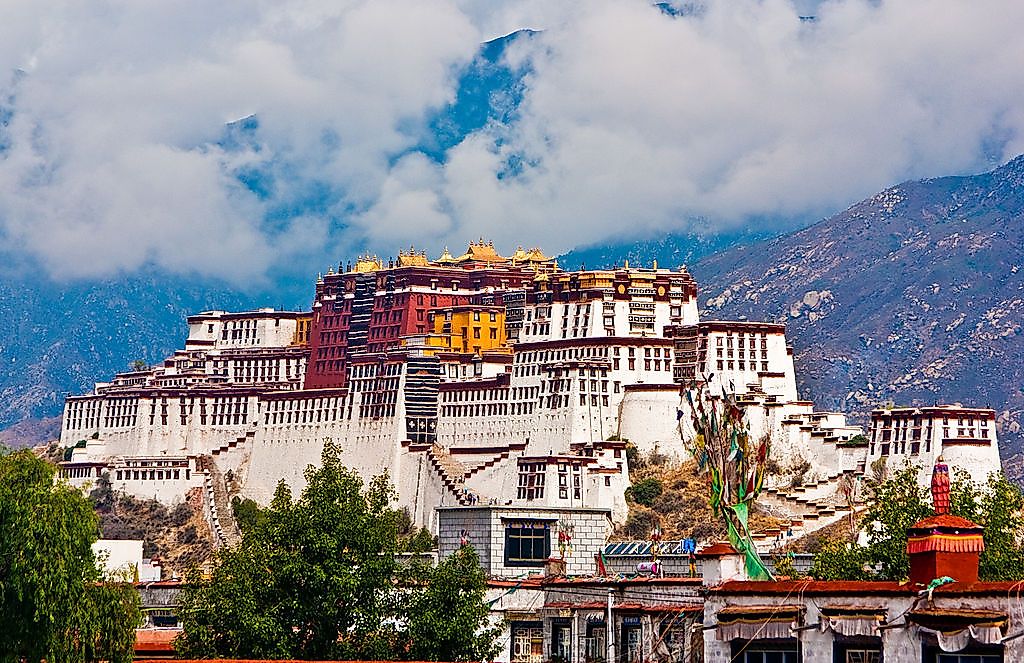Where Is The World's Highest Palace Located?

Where Is The Potala Palace?
The Potala Palace, the world’s highest palace, is located in Lhasa, Tibet Autonomous Region. It is located at an altitude of 12,100 feet from sea level on the “Red Hill” in the Lhasa Valley. It served as the residence of the Dalai Lama, the chief authority of Tibetan Buddhism until the 14th Dalai Lama was forced to flee to India during the 1959 Tibetan uprising. The Potala Palace is currently promoted by the Chinese government as a tourist site. It has been declared a World Heritage Site by the UNESCO.
History Of The Potala Palace
The Potala Palace that we see today was erected at the site of another ancient palace. Reminders of this ancient building remain in the form of two chapels at the northwest corner of the current palace that conserves parts of the older building. The new Potala Palace was commissioned to be built by the Great Fifth Dalai Lama, Lozang Gyatso in 1645. The location of the palace between the old city of Lhasa and the Drepung and Sera monasteries made it an ideal seat of the government of Tibet. The exterior structures of the Potala Palace were built in only 3 years while the interiors took much longer to complete. Construction of the palace lasted until 1694, 12 years after the death of the Great Fifth Dalai Lama. The Red Palace was completed between 1690 and 1694.
The Potala Palace suffered slight damages during the 1959 Tibetan uprising against the Chinese. The personal intervention of the Chinese Premier Zhou Enlai saved the palace from the 1966 Cultural Revolution. However, all the 100,000 volumes of literary work and sacred scriptures were destroyed during this time.
In 1994, the Potala Palace was inscribed as a UNESCO World Heritage Site. Two other nearby heritage sites, the Norbulingka and the Jokhang Temple were added as extensions to the site.
Architecture Of The Potala Palace
The Potala Palace is 400 meters long from east to west, and 350 meters long from north to south. It has sloping stone walls that are five meters thick at the base and an average of 3 meters thick. Copper has been poured into the foundations of the palace to save it from damage by earthquakes. The 13-storied building rises 117 meters on top of the “Red Hill” or Marpo Ri. The hill rises 300 meters above the valley floor.
The White Palace
The White Palace is the section of the Potala Palace that serves as the residence of the Dalai Lama. It was first built during the lifetime of the Fifth Dalai Lama who moved into the palace with his government in 1649. The 13th Dalai Lama extended the palace to what can be seen today. The White Palace houses the living quarters, printing house, offices, and seminary of the Dalai Lama.
The Red Palace
The other side of the Potala Palace, separated by a courtyard called the Deyangshar, is occupied by the Red Palace which is completely devoted to prayers and religious studies. The Red Palace hosts the tombs of the eight Dalai Lamas, numerous shrines and chapels, the assembly hall of the monks, sacred gold stupas, and large libraries of Buddhist sacred scriptures.
Threats And Remedies
Rapid modernisation of the area around the Potala Palace has been a concern for UNESCO. Large, modern buildings constructed around the palace would threaten the serene atmosphere and unique qualities of the palace region. The concerns of UNESCO were addressed by the Chinese government, who responded by barring the construction of structures higher than 21 meters in the area of the Potala Palace. To reduce visitor footfall and overcrowding in the Potala Palace, the number of visitors was restricted to 1,600 and the visiting time was reduced to 6 hours a day. This arrangement would help the palace authorities to manage the crowd which sometimes was a high as 5,000 vistiors a day. The roof of the palace was also closed to visitors to avoid structural damage.











